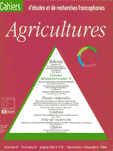Tolérance au flétrissement bactérien chez la tomate induite après vitroculture
Résumé
Vitrovariations have been tentatively used by plant breeders, but there are relatively few documented examples of variant traits being stabilized through sexual reproduction. Neoformed tomato plants were regenerated after vitroculture of calli inoculated with Pseudomonas solanacearum, the causal agent of bacterial wilt. Surviving resistant calli gave variant plants exhibiting tolerance to bacterial wilt, although the initial tomato lines were susceptible. The first and second selfed generations from these variant plants were experimentally contaminated and tested in plots. They exhibited the same level of field tolerance as the initial regenerated variant plant. There was no segregation among the progeny (see Tables 1 and 2). Several hypotheses are proposed to explain these results. As tomato is an autogamous species (naturally reproduced by selfing), tolerant familles could hopefully be the source of new tomato varieties with sustainable tolerance to bacterial wilt.Téléchargements
Publié
1996-11-01
Comment citer
Nsika Mikoko, E. . (1996). Tolérance au flétrissement bactérien chez la tomate induite après vitroculture. Cahiers Agricultures, 5(6), 460–462 (1). Consulté à l’adresse https://revues.cirad.fr/index.php/cahiers-agricultures/article/view/29981
Numéro
Rubrique
Articles

